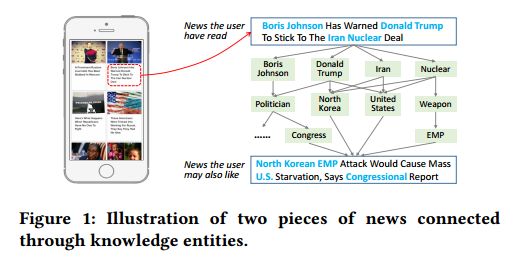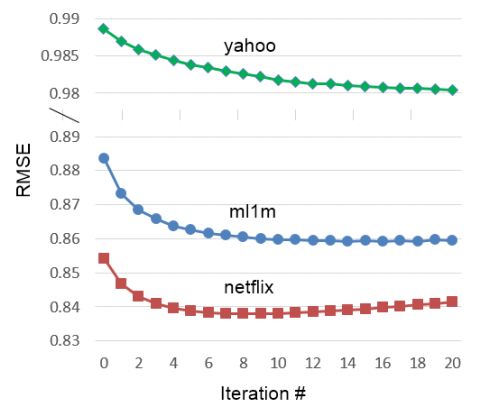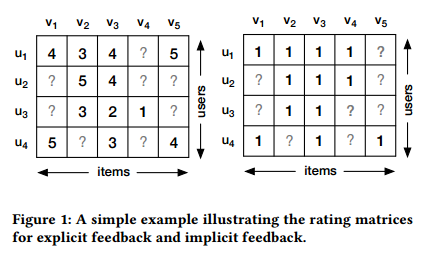【论文推荐】最新6篇推荐系统(Recommendation System)相关论文—深度、注意力、安全、可解释性、评论、自编码器
【导读】专知内容组整理了最近六篇推荐系统(Recommendation System)相关文章,为大家进行介绍,欢迎查看!
1. DKN: Deep Knowledge-Aware Network for News Recommendation(DKN:基于深度知识语义网络的新闻推荐)
作者:Hongwei Wang,Fuzheng Zhang,Xing Xie,Minyi Guo
摘要:Online news recommender systems aim to address the information explosion of news and make personalized recommendation for users. In general, news language is highly condensed, full of knowledge entities and common sense. However, existing methods are unaware of such external knowledge and cannot fully discover latent knowledge-level connections among news. The recommended results for a user are consequently limited to simple patterns and cannot be extended reasonably. Moreover, news recommendation also faces the challenges of high time-sensitivity of news and dynamic diversity of users' interests. To solve the above problems, in this paper, we propose a deep knowledge-aware network (DKN) that incorporates knowledge graph representation into news recommendation. DKN is a content-based deep recommendation framework for click-through rate prediction. The key component of DKN is a multi-channel and word-entity-aligned knowledge-aware convolutional neural network (KCNN) that fuses semantic-level and knowledge-level representations of news. KCNN treats words and entities as multiple channels, and explicitly keeps their alignment relationship during convolution. In addition, to address users' diverse interests, we also design an attention module in DKN to dynamically aggregate a user's history with respect to current candidate news. Through extensive experiments on a real online news platform, we demonstrate that DKN achieves substantial gains over state-of-the-art deep recommendation models. We also validate the efficacy of the usage of knowledge in DKN.
期刊:arXiv, 2018年1月30日
网址:
http://www.zhuanzhi.ai/document/f18c88d4cd335b0408f90dfe97f6e937
2. Multi-Pointer Co-Attention Networks for Recommendation(基于多Pointer协同Attention网络的推荐方法)
作者:Yi Tay,Luu Anh Tuan,Siu Cheung Hui
摘要:Many recent state-of-the-art recommender systems such as D-ATT, TransNet and DeepCoNN exploit reviews for representation learning. This paper proposes a new neural architecture for recommendation with reviews. Our model operates on a multi-hierarchical paradigm and is based on the intuition that not all reviews are created equal, i.e., only a select few are important. The importance, however, should be dynamically inferred depending on the current target. To this end, we propose a review-by-review pointer-based learning scheme that extracts important reviews, subsequently matching them in a word-by-word fashion. This enables not only the most informative reviews to be utilized for prediction but also a deeper word-level interaction. Our pointer-based method operates with a novel gumbel-softmax based pointer mechanism that enables the incorporation of discrete vectors within differentiable neural architectures. Our pointer mechanism is co-attentive in nature, learning pointers which are co-dependent on user-item relationships. Finally, we propose a multi-pointer learning scheme that learns to combine multiple views of interactions between user and item. Overall, we demonstrate the effectiveness of our proposed model via extensive experiments on \textbf{24} benchmark datasets from Amazon and Yelp. Empirical results show that our approach significantly outperforms existing state-of-the-art, with up to 19% and 71% relative improvement when compared to TransNet and DeepCoNN respectively. We study the behavior of our multi-pointer learning mechanism, shedding light on evidence aggregation patterns in review-based recommender systems.
期刊:arXiv, 2018年1月29日
网址:
http://www.zhuanzhi.ai/document/e9f1c53baa02dc2313884fb105e28c3f
3. CryptoRec: Secure Recommendations as a Service(CryptoRec: 作为服务的安全推荐方法)
作者:Jun Wang,Afonso Arriaga,Qiang Tang,Peter Y. A. Ryan
摘要:Recommender systems rely on large datasets of historical data and entail serious privacy risks. A server offering recommendations as a service to a client might leak more information than necessary regarding its recommendation model and training dataset. At the same time, the disclosure of the client's preferences to the server is also a matter of concern. Providing recommendations while preserving privacy in both senses is a difficult task, which often comes into conflict with the utility of the system in terms of its recommendation-accuracy and efficiency. Widely-purposed cryptographic primitives such as secure multi-party computation and homomorphic encryption offer strong security guarantees, but in conjunction with state-of-the-art recommender systems yield far-from-practical solutions. We precisely define the above notion of security and propose CryptoRec, a novel recommendations-as-a-service protocol, which encompasses a crypto-friendly recommender system. This model possesses two interesting properties: (1) It models user-item interactions in a user-free latent feature space in which it captures personalized user features by an aggregation of item features. This means that a server with a pre-trained model can provide recommendations for a client without having to re-train the model with the client's preferences. Nevertheless, re-training the model still improves accuracy. (2) It only uses addition and multiplication operations, making the model straightforwardly compatible with homomorphic encryption schemes.
期刊:arXiv, 2018年2月7日
网址:
http://www.zhuanzhi.ai/document/bb0ed8460851c7bf487a72f28d2c7f11
4. Visually Explainable Recommendation(视觉可解释性的推荐方法)
作者:Xu Chen,Yongfeng Zhang,Hongteng Xu,Yixin Cao,Zheng Qin,Hongyuan Zha
摘要:Images account for a significant part of user decisions in many application scenarios, such as product images in e-commerce, or user image posts in social networks. It is intuitive that user preferences on the visual patterns of image (e.g., hue, texture, color, etc) can be highly personalized, and this provides us with highly discriminative features to make personalized recommendations. Previous work that takes advantage of images for recommendation usually transforms the images into latent representation vectors, which are adopted by a recommendation component to assist personalized user/item profiling and recommendation. However, such vectors are hardly useful in terms of providing visual explanations to users about why a particular item is recommended, and thus weakens the explainability of recommendation systems. As a step towards explainable recommendation models, we propose visually explainable recommendation based on attentive neural networks to model the user attention on images, under the supervision of both implicit feedback and textual reviews. By this, we can not only provide recommendation results to the users, but also tell the users why an item is recommended by providing intuitive visual highlights in a personalized manner. Experimental results show that our models are not only able to improve the recommendation performance, but also can provide persuasive visual explanations for the users to take the recommendations.
期刊:arXiv, 2018年1月31日
网址:
http://www.zhuanzhi.ai/document/7c022e9571b5ac32de8fa4a8cd77c83e
5. TransRev: Modeling Reviews as Translations from Users to Items(TransRev: 基于评论信息建模用户和商品的推荐方法)
作者:Alberto Garcia-Duran,Roberto Gonzalez,Daniel Onoro-Rubio,Mathias Niepert,Hui Li
摘要:The text of a review expresses the sentiment a customer has towards a particular product. This is exploited in sentiment analysis where machine learning models are used to predict the review score from the text of the review. Furthermore, the products costumers have purchased in the past are indicative of the products they will purchase in the future. This is what recommender systems exploit by learning models from purchase information to predict the items a customer might be interested in. We propose TransRev, an approach to the product recommendation problem that integrates ideas from recommender systems, sentiment analysis, and multi-relational learning into a joint learning objective. TransRev learns vector representations for users, items, and reviews. The embedding of a review is learned such that (a) it performs well as input feature of a regression model for sentiment prediction; and (b) it always translates the reviewer embedding to the embedding of the reviewed items. This allows TransRev to approximate a review embedding at test time as the difference of the embedding of each item and the user embedding. The approximated review embedding is then used with the regression model to predict the review score for each item. TransRev outperforms state of the art recommender systems on a large number of benchmark data sets. Moreover, it is able to retrieve, for each user and item, the review text from the training set whose embedding is most similar to the approximated review embedding.
期刊:arXiv, 2018年1月31日
网址:
http://www.zhuanzhi.ai/document/6c3798e86cd9f99308349c17bc03a0d2
6. Collaborative Autoencoder for Recommender Systems(协同自编码器的推荐系统)
作者:Qibing Li,Xiaolin Zheng,Xinyue Wu
摘要:In recent years, deep neural networks have yielded state-of-the-art performance on several tasks. Although some recent works have focused on combining deep learning with recommendation, we highlight three issues of existing works. First, most works perform deep content feature learning and resort to matrix factorization, which cannot effectively model the highly complex user-item interaction function. Second, due to the difficulty on training deep neural networks, existing models utilize a shallow architecture, and thus limit the expressive potential of deep learning. Third, neural network models are easy to overfit on the implicit setting, because negative interactions are not taken into account. To tackle these issues, we present a generic recommender framework called Neural Collaborative Autoencoder (NCAE) to perform collaborative filtering, which works well for both explicit feedback and implicit feedback. NCAE can effectively capture the relationship between interactions via a non-linear matrix factorization process. To optimize the deep architecture of NCAE, we develop a three-stage pre-training mechanism that combines supervised and unsupervised feature learning. Moreover, to prevent overfitting on the implicit setting, we propose an error reweighting module and a sparsity-aware data-augmentation strategy. Extensive experiments on three real-world datasets demonstrate that NCAE can significantly advance the state-of-the-art.
期刊:arXiv, 2018年1月30日
网址:
http://www.zhuanzhi.ai/document/1b35f909ea02215eff913e4ac458acda
-END-
专 · 知
人工智能领域主题知识资料查看获取:【专知荟萃】人工智能领域26个主题知识资料全集(入门/进阶/论文/综述/视频/专家等)
同时欢迎各位用户进行专知投稿,详情请点击:
【诚邀】专知诚挚邀请各位专业者加入AI创作者计划!了解使用专知!
请PC登录www.zhuanzhi.ai或者点击阅读原文,注册登录专知,获取更多AI知识资料!
请扫一扫如下二维码关注我们的公众号,获取人工智能的专业知识!
请加专知小助手微信(Rancho_Fang),加入专知主题人工智能群交流!
点击“阅读原文”,使用专知!












